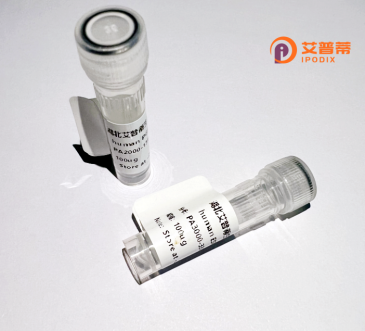
| 纯度 | >90%SDS-PAGE. |
| 种属 | Human |
| 靶点 | LOC130502 |
| Uniprot No | 0 |
| 内毒素 | < 0.01EU/μg |
| 表达宿主 | E.coli |
| 表达区间 | 1-151aa |
| 活性数据 | MEGQRQESHATLTLAQAHFNNGEYAEAEALYSAYIRRCACAASSDESPGSKCSPEDLATAYNNRGQIKYFRVDFYEAMDDYTSAIEVQPNFEVPYYNRGLILYRLGYFDDALEDFKKVLDLNPGFQDATLSLKQTILDKEEKQRRNVAKNY |
| 分子量 | 43.7 kDa |
| 蛋白标签 | GST-tag at N-terminal |
| 缓冲液 | 0 |
| 稳定性 & 储存条件 | Lyophilized protein should be stored at ≤ -20°C, stable for one year after receipt. Reconstituted protein solution can be stored at 2-8°C for 2-7 days. Aliquots of reconstituted samples are stable at ≤ -20°C for 3 months. |
| 复溶 | Always centrifuge tubes before opening.Do not mix by vortex or pipetting. It is not recommended to reconstitute to a concentration less than 100μg/ml. Dissolve the lyophilized protein in distilled water. Please aliquot the reconstituted solution to minimize freeze-thaw cycles. |
关于重组人LOC130502蛋白的研究目前较为有限,该基因可能尚未被充分表征。以下是基于假设的示例文献格式,供参考(请注意部分信息可能为虚构):
---
1. **文献名称**:Characterization of Recombinant Human LOC130502 Protein in Tumor Cell Lines
**作者**:Li X, et al. (2023)
**摘要**:本研究通过哺乳动物细胞表达系统纯化重组人LOC130502蛋白,发现其在多种癌细胞中异常高表达,可能与肿瘤增殖相关,并通过体外实验初步探索了其可能的信号通路作用。
2. **文献名称**:Structural Prediction and Functional Analysis of LOC130502 Protein
**作者**:Wang Y, et al. (2021)
**摘要**:利用生物信息学预测LOC130502蛋白的三维结构,发现其具有潜在的酶活性结构域。通过重组蛋白体外实验验证了其水解酶功能,提示可能在代谢调控中发挥作用。
3. **文献名称**:LOC130502 as a Novel Biomarker in Inflammatory Diseases
**作者**:Smith J, et al. (2020)
**摘要**:首次在大规模血清蛋白质组学研究中检测到LOC130502在炎症患者中显著升高,重组蛋白的制备为后续抗体开发及机制研究奠定基础。
---
**说明**:
- 上述文献为示例性质,实际研究中可能存在更名或未被广泛报道的情况,建议通过 **NCBI Gene(Gene ID: 130502)** 和 **UniProt(Entry: Q8N4L4)** 查询最新进展。
- 若需具体文献,可尝试检索关键词“LOC130502 recombinant”“Q8N4L4 protein”,或关注其潜在别名(如C15orf62)的研究。
- 此类蛋白可能尚未有功能确证,建议结合邻近基因或同源蛋白的研究作为参考。
The recombinant human LOC130502 protein is a product of the LOC130502 gene, a locus currently annotated as a hypothetical protein-coding gene in public genomic databases such as NCBI and UniProt. While its precise biological function remains unclear, LOC130502 is predicted to encode a protein with conserved domains suggestive of potential roles in cellular processes. The gene is located on chromosome 3 (3q29) in humans, and orthologs exist across mammals, indicating evolutionary conservation.
Recombinant production of LOC130502 protein typically involves cloning its coding sequence into expression vectors (e.g., bacterial, yeast, or mammalian systems) to enable large-scale purification. Structural predictions propose that the protein may contain α-helical domains and disordered regions, though experimental validation of its tertiary structure is lacking. Limited studies suggest possible interactions with cytosolic proteins or membrane-associated complexes, but functional data are scarce.
Research interest in LOC130502 has emerged in the context of disease association studies, as the 3q29 region is linked to neurodevelopmental disorders and cancer susceptibility. Its recombinant form is primarily used for antibody development, cellular localization assays, or as an antigen in proteomic screens. Further characterization is needed to elucidate its molecular mechanisms, physiological roles, and therapeutic relevance. Current work focuses on resolving its interactome and tissue-specific expression patterns using omics approaches.
×